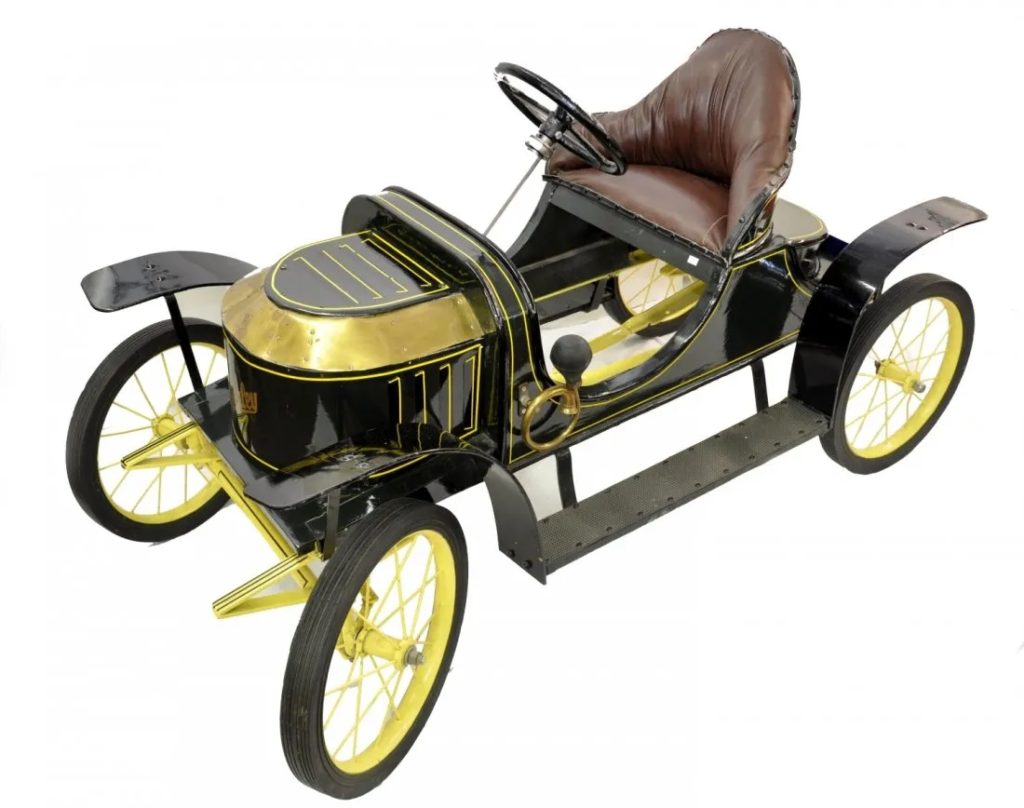STEAM PEDAL POWER
Currently adorning the Marshall Steam Museum is a collection of vintage pedal cars. From a private collection, they are on loan to the Friends of Auburn Heights while the collection awaits auction in the late fall. While there are no Stanley, White, or Doble steam pedal cars on display, we are wondering if any pedal cars might have been mass produced that were modeled after one of the major steam car manufacturers?
Answer
According to multiple sources, the child’s pedal car dates back to the 1890s. As there were both wooden and metal horses mounted on wheels for children to ride in the 1800s, once actual motor carriages began to appear, the evolution of a toy motor carriage propelled by little feet followed suit. The first cars were simply moved by the child’s feet on the ground and bending at the knees to move the toy about. In the 1890s the idea of changing the rear wheel axle shaft to a crankshaft configuration, adding rods with pedals ‘under the hood’ so the toy car might be propelled by the child riding it was a natural evolution. Thus began the pedal car as we know it today.
Pedal cars were available through the Sears, Montgomery Ward, and other catalogs and were shipped as freight to the local railroad station where they might be picked up. This limited pedal car availability to affluent families at the start of the 1900s thus vintage pedal cars are rare and expensive for collectors. In the 1950s, mass production and the ability to ship crates of cars to department stores reduced prices and increased availability making pedal cars very popular. Toledo, Ohio became the ‘Detroit’ of pedal cars with American National Company absorbing several pedal car manufacturers in the 1920s to become the world’s largest children’s vehicle manufacturing company by the 1930s. The company’s ‘Skippy Line’ featured pedal cars patterned after the major car models of the era.
The Great Depression nearly stopped all pedal car production and production did stop during World War II as all non-essential metal use was prohibited. After the war, the ‘drive train’ for some manufacturers changed to a bicycle chain between sprockets making the cars easier to pedal. To attract sales, pedal-vehicles changed to include trucks, locomotives, airplanes, and even boats. The era of the all-metal, rider-pedaled, pedal car ended in the 1970s with Louis Marx & Company’s Big Wheel all-plastic tricycle and its safety features. By the end of the 20th century the classic metal pedal car was replaced by the plastic, electric motor powered, toy car!


To the best of our research, no Stanley, White, or Doble pedal cars were ever commercially mass produced. There are two Stanley pedal cars in existence. Both were one-of-a-kind custom built. Photos of each are shown on this page. If you’re wondering the value of a vintage pedal car it is similar to an actual vintage automobile or even an antique item. Generally, there are five major considerations; age, condition, percent original, demand, and rarity. While most pedal cars trade owners for three- or four-digit figures, a few have commanded a five-digit auction price!
